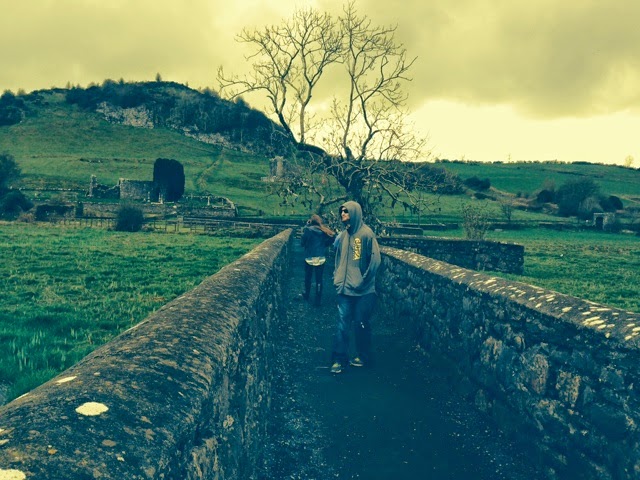The next day we went to Fore. It is a small town in County Westmeath. There are several ruins in the area.
St. Feichin founded a monastery near the town around 630 AD. The signs state that St. Taurin was the patron saint of the monastic house
at Evereux in Normandy, and that St. Feichin chose St. Taurin as the patron saint for his monastery. As a result of the direct relationship with a
French Abbey, Fore was routinely seized by the crown as "alien property"
when England was at war with France.
I included these pictures from the sign posts as I did not get good pictures of the monastery and it's buildings. It was across the road from the Priory and we did not go across to it. These shots from the sign post are taken from above, standing on the hill. The hill is known as The Ben of Fore.
Below is my shot of the Anchorite Church from across the road.
The above shot is of the Ben of Fore and the monastery ruins. St. Feichin's Church is in the foreground near the large patch of trees, and the Anchorite's Church is back further and up the hill to the right. Almost all that remains of the monastery are the two churches. The information tells us that when it was flourishing, St. Feichin's had over 300 monks and 2000 students studying there. St. Feichin's church had a Greek cross in relief over the lintelled doorway. The story goes that the workmen were unable to lift the stone to place the lintel over the door, and when they came back after their morning meal, it was miraculously in place. The legend spread that St. Feichin himself put the lintel over the doorway while the men ate their breakfast.
The Benedictine Priory was founded by Hugh
de Lacy around 1180 AD. The path leading up to the Priory is long and winding and it is protected by stone walls. There are trees used as wishing trees here, and there is water flowing through the land and ancient wells that are said to hold healing powers.
I hit something on my phone and my camera started doing every picture in black and white. I went back to try to correct it, but some photos just refused to be corrected! So, the black and white ones will have to be included, though they make it seem much more ominous than it was!
Yes, I was here! And, you can tell it was bright out because my glasses are shaded! Still, it was a bit windy and chilly at times.
Then miraculously, the colors came back! It must have been because we were in the Chapel!
This was in the chapel, and I didn't realize it at the time I took the photo, but apparently it is unusual to have two of these basins next to each other. Perhaps that is why it it protected with the wire mesh. Also, it would be a sacred spot as it is where the priest would handle the Eucharist, wash, and combine the water and wine. (I learned this on our tour of Trim, which also has two of these next to each other in the Chapel.)
I thought this was interesting as it gives you an idea what the central cloister, or courtyard, of the priory would have looked like with all the arcs in place.
I hit something on my phone and my camera started doing every picture in black and white. I went back to try to correct it, but some photos just refused to be corrected! So, the black and white ones will have to be included, though they make it seem much more ominous than it was!
Yes, I was here! And, you can tell it was bright out because my glasses are shaded! Still, it was a bit windy and chilly at times.
Then miraculously, the colors came back! It must have been because we were in the Chapel!
This was in the chapel, and I didn't realize it at the time I took the photo, but apparently it is unusual to have two of these basins next to each other. Perhaps that is why it it protected with the wire mesh. Also, it would be a sacred spot as it is where the priest would handle the Eucharist, wash, and combine the water and wine. (I learned this on our tour of Trim, which also has two of these next to each other in the Chapel.)
I thought this was interesting as it gives you an idea what the central cloister, or courtyard, of the priory would have looked like with all the arcs in place.
The Dovecote or Pigeon Coop. I can tell you that such birds must have been good eating because, around here the ring-necked dove is a HUGE bird that seems to have a VERY TOUGH TIME flying up off the ground! I am careful though as I believe they would dent the car! Just saying....
Final piece of information: Another poet for me to check out!







































No comments:
Post a Comment